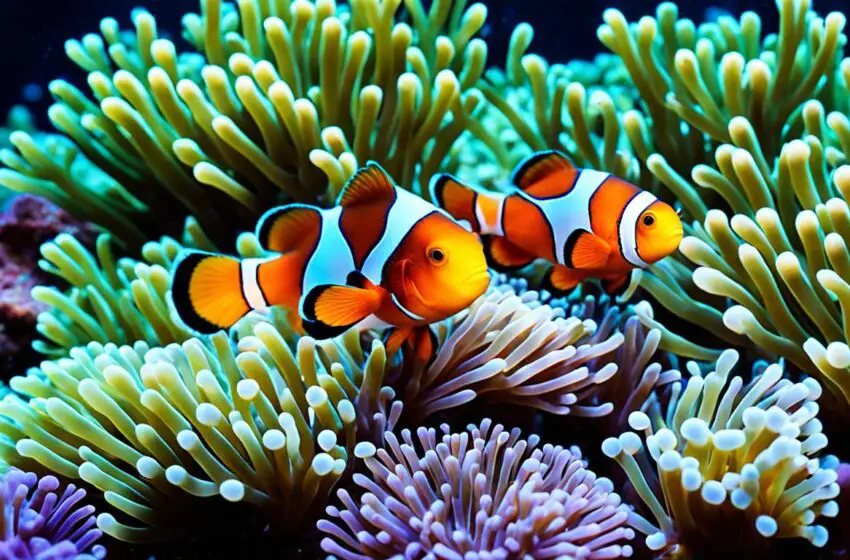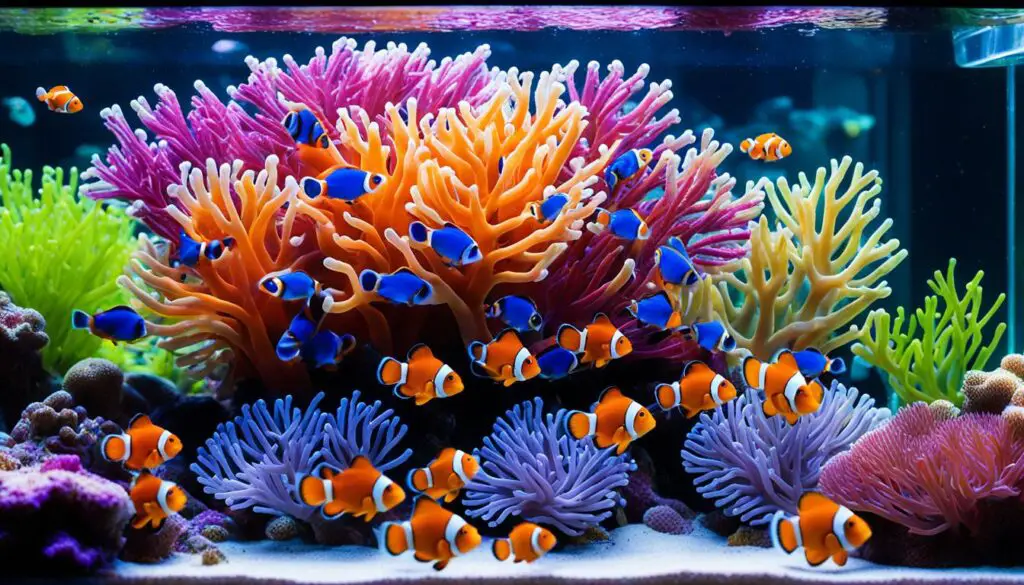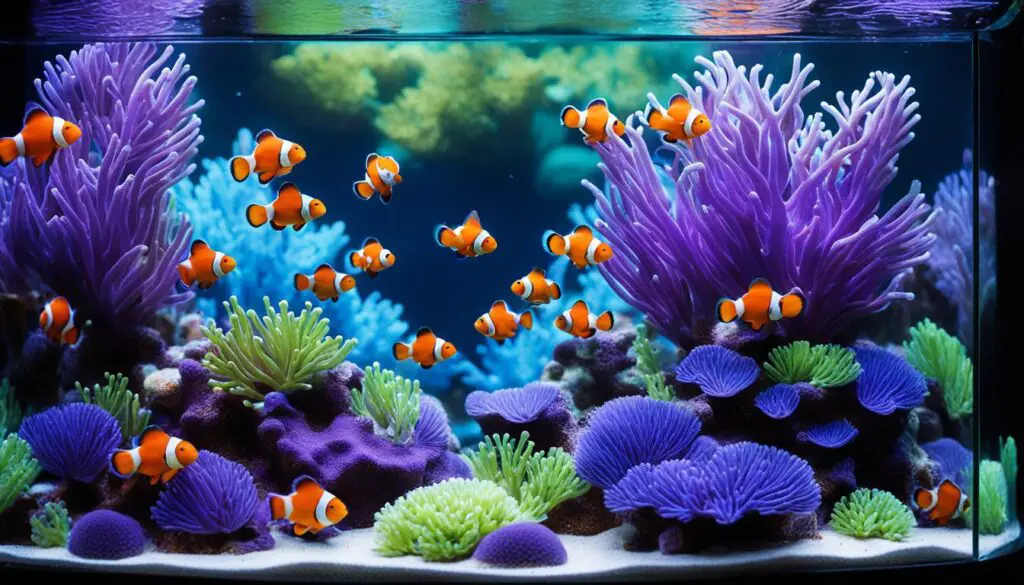Mastering Clownfish Tank Parasite Control: Essential Strategies

Setting up a new tank often means dealing with an “ugly phase.” This stage is when diatoms, cyanobacteria, and dinoflagellates take over. They make the tank look bad and harm its health. So, it’s vital to learn how to beat these parasites for a beautiful, healthy aquarium.
Key Takeaways:
- Encountering an “ugly phase” with the growth of unwanted organisms is inevitable when setting up a new clownfish tank.
- Diatoms, cyanobacteria, and dinoflagellates are common parasites that thrive during the adjustment phase of the tank.
- Controlling these parasites is crucial for the aesthetics and overall health of the clownfish tank.
- Specific strategies need to be implemented to manage diatom, cyanobacteria, and dinoflagellate outbreaks effectively.
- Regular monitoring and follow-up treatments may be necessary to maintain a thriving aquarium.
Understanding and Managing Diatom Outbreaks in Clownfish Tanks
Diatoms often show up in clownfish tanks when they’re going through an “ugly phase.” These are tiny brown algae that form hard brown spots, especially on the tank’s glass. Although they can make your tank look less pretty, you can deal with them by knowing more about them and taking the right steps.
The main cause of diatom outbreaks in clownfish tanks is too much silicon. This can come from different places like new salt mixes, live rocks, or silicon-rich water. The excess silicon makes diatoms flourish, leading to those brown spots you see.
But, here’s the good news: diatoms usually go away as the extra silicon in the tank naturally decreases. Over time, your tank will develop other types of algae, making the environment more balanced and attractive. If diatoms stick around too long or appear in large amounts, it might signal a silicon issue in your water source.
To fix high silicon in your water source, you can use special cartridges in a Reverse Osmosis Deionization (RO/DI) unit. These cartridges remove the silicon, making sure the water that goes into your tank is silicon-free. Changing these cartridges regularly and checking the silicon levels can stop diatoms from coming back.
By learning how to deal with diatoms, you make a better home for your clownfish. Following the advice we shared, you can keep your tank looking great and your fish happy. It’s all about creating the right environment for everyone to enjoy.
Preventing Diatom Outbreaks: Quick Tips
- Use properly rinsed live rock to reduce the initial silicon content in the tank.
- Choose a salt mix with lower silicon levels.
- Perform regular water testing to monitor silicon levels and overall water quality.
- Consider using diatomaceous earth powder as a temporary solution to minimize diatom appearance if necessary.

Managing Cyanobacteria Outbreaks in Clownfish Tanks
Cyanobacteria, or “cyano,” is a big issue in clownfish tanks. It thrives where there’s too much food and low water flow, often in forgotten corners. In new tanks, a lack of water movement adds to the problem.
Several strategies can help you get rid of cyano and stop it from coming back:
- Siphon Detritus: Removing detritus during water changes is key. It gets rid of food for cyano. Be sure to check the areas where water doesn’t move well.
- Improve Water Flow: Better water circulation prevents dead spots and cyano. Try moving powerheads or adding more pumps to get the water moving.
- Hydrogen Peroxide Treatment: You can use hydrogen peroxide on cyano. Just put a little on the affected areas. But be careful not to shock your fish. Always follow the right use instructions.
- Blackout Periods: A blackout can stop cyano. Try turning off lights or covering the tank for a while. Watch your water’s health closely during this time to keep your fish safe.
Even though there are products to treat cyano, it’s best to fix the main issues. Keep up with tank care and watch how much food your fish get. This helps keep cyanobacteria away for good.

Managing Dinoflagellate Outbreaks in Clownfish Tanks
Dinoflagellates are tiny but can cause big problems in clownfish tanks, especially new ones. These outbreaks are tough to get rid of. They might need more than one treatment to fully clear them up.
For dinos floating around freely, a UV sterilization setup can work wonders. It kills them as water flows through the system. This stops dinoflagellates from making more of themselves, lowering their numbers over time.
If the dinos are clinging to rocks and substrate, you need a different plan. Try boosting nutrient levels by tweaking the feeding schedule or adding special foods and supplements. This helps other organisms grow, beating the dinoflagellates at their own game.
Using good bacteria, found in live rock or in special products, is another smart strategy. They make the environment more stable. This makes it harder for dinoflagellates to take over.
Another useful tactic is a blackout period. Cover the tank for a few days to cut off light. This discourages dinoflagellates, giving better organisms a chance to flourish.
Keep a close eye on the water quality and the tank’s general state. This ongoing check helps catch dinoflagellates early. For really tough cases, further treatments might be needed. This is especially vital if your fish are from the wild. With these steps, you can beat dinoflagellate outbreaks and keep your fish happy.
FAQ
What is the “ugly phase” of a clownfish tank?
The “ugly phase” happens when you start a new tank. You’ll see diatoms, cyanobacteria, and dinoflagellates. These can make everything look dirty.
What are diatoms and how do they affect a clownfish tank?
Diatoms are hard, brown spots mainly on the glass. They love silicate, which may come from new salt, live rock, or high-silicate water. As silicates lessen, so do diatoms.
How can I control diatom outbreaks in my clownfish tank?
To fight diatoms, check your source water for high silicate. Use special filters to clear silicon. Keep the tank clean with regular changes and watch it closely.
What is cyanobacteria, and why does it appear in clownfish tanks?
Cyanobacteria, or “cyano,” like rich nutrients and form slimy layers. They show up in nooks where dirt gathers. Lack of water movement can cause their overgrowth.
How can I manage cyanobacteria outbreaks in my clownfish tank?
Deal with cyano by cleaning during water changes. Boost water circulation. For severe cases, use hydrogen peroxide or a tank blackout. Fixing the source of excess nutrients helps for a lasting solution.
What are dinoflagellates, and why are they a challenge in clownfish tanks?
Dinoflagellates are tough to deal with in new or unstable tanks. These single-cell beings look like brown slime and can cause big problems.
How can I manage dinoflagellate outbreaks in my clownfish tank?
To tackle free-floating dinos, UV sterilizers work well. For those on surfaces, balance nutrients, add helpful bacteria, and try a blackout. Keep a close eye and be ready to repeat these steps, particularly with wild-caught fish.
